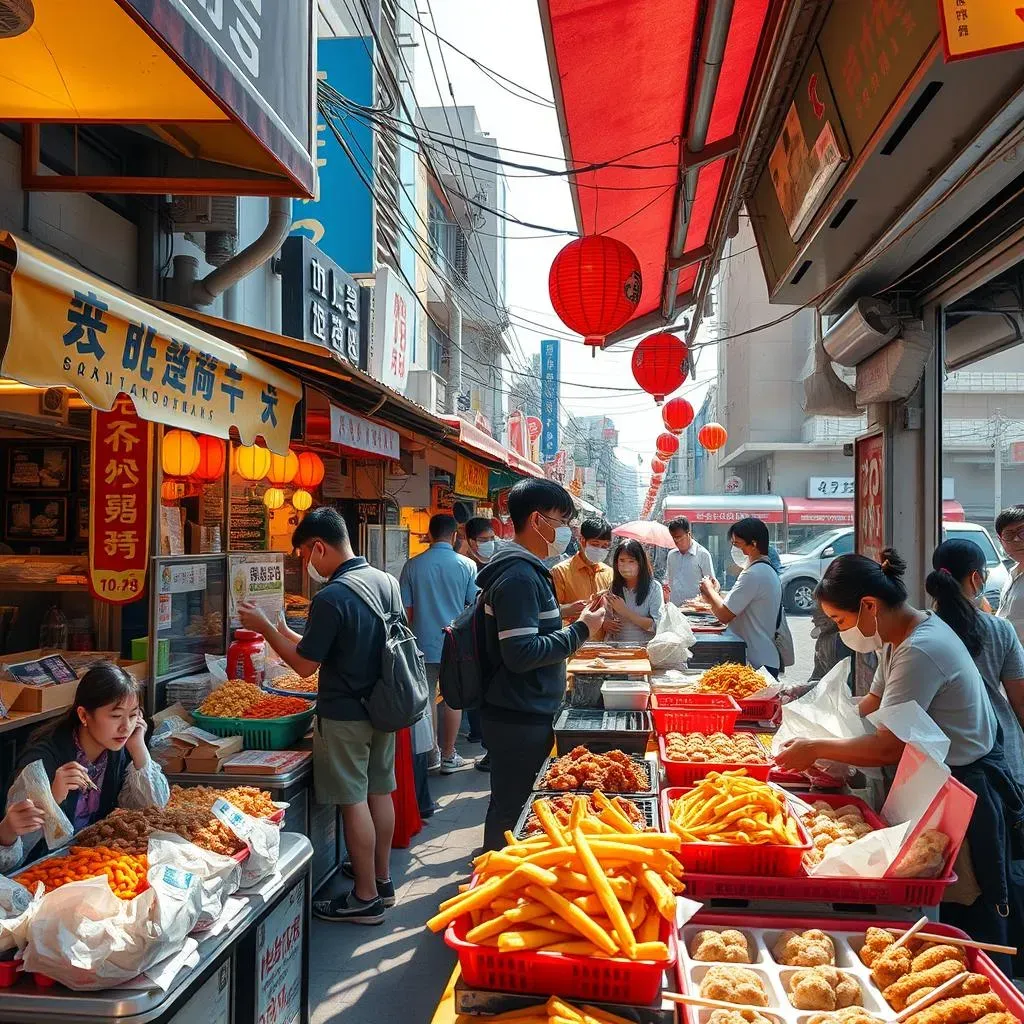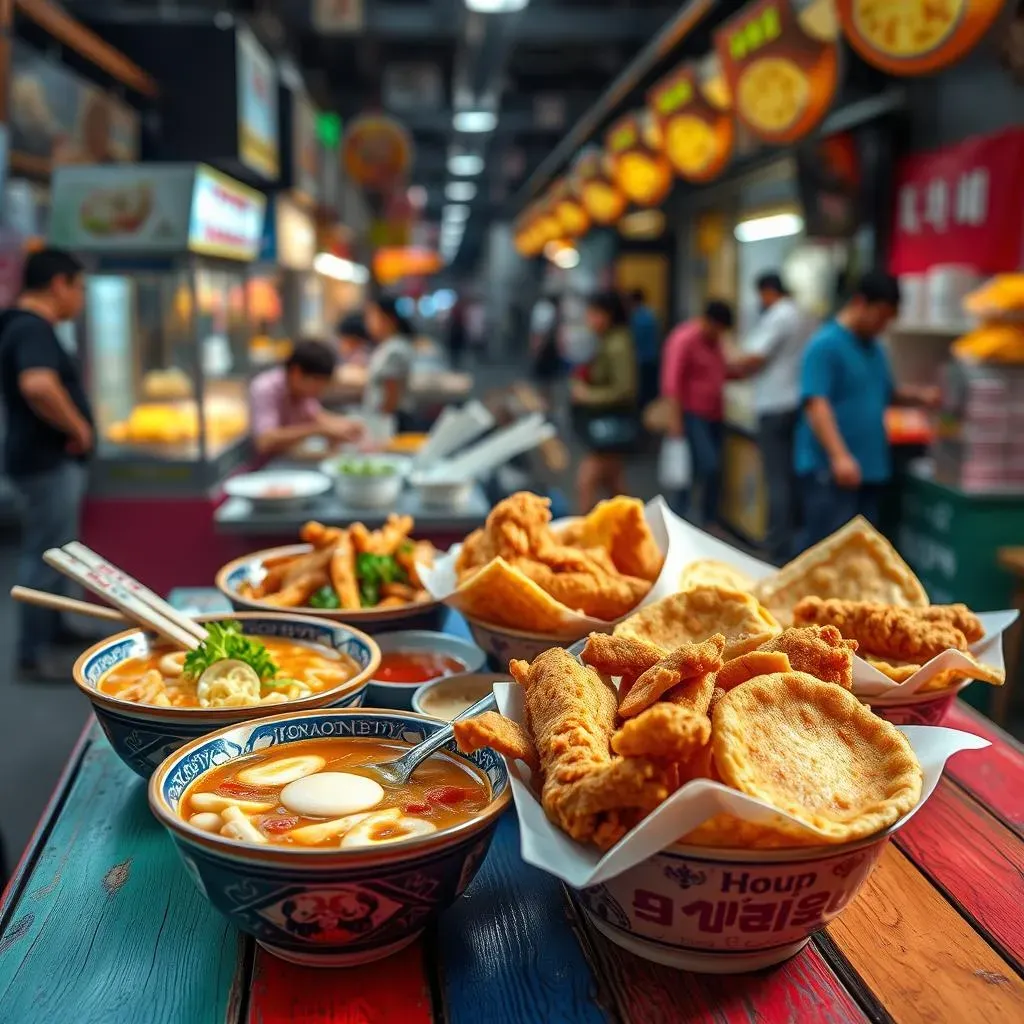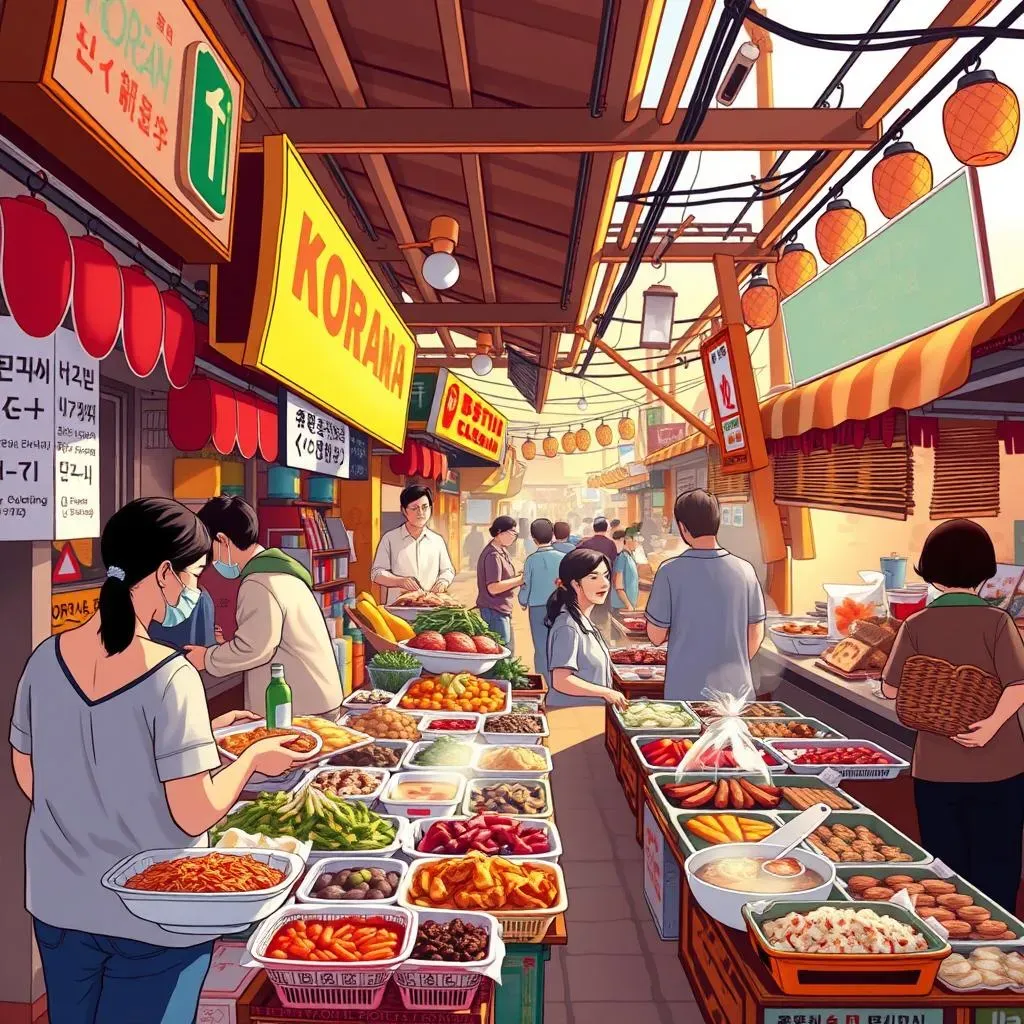Table of Contents
Get ready for a culinary journey through the bustling streets of Korea! This article is your passport to the vibrant and diverse world of Korean street food. From the sweet and spicy explosion of tteokbokki to the savory goodness of hotteok, we'll explore the most iconic dishes that define this unique food culture. We'll uncover the history and traditions behind these tempting treats, revealing how Korean street food reflects the country's rich culinary heritage. But this isn't just a food guide; it's an invitation to experience the energy and excitement of Korean street markets, where the aroma of sizzling meats and sweet pastries fills the air. Whether you're a seasoned foodie or a curious newcomer, prepare to have your taste buds tantalized and your senses awakened as we embark on this delicious adventure together. So, let's dive into the amazing world of Korean street food and discover why it's a must-try experience for any traveler or food enthusiast.
Exploring the Vibrant World of Korean Street Food
Exploring the Vibrant World of Korean Street Food
A Sensory Overload
Imagine this: You're strolling through a bustling Korean street market, the air thick with the aroma of sizzling meats, sweet pastries, and spicy sauces. Brightly colored tents and carts overflow with tempting treats, each vendor vying for your attention with their unique culinary creations. The sounds are just as captivating – the sizzle of hotteok on the griddle, the cheerful chatter of vendors, and the happy murmurs of customers savoring their delicious finds. Korean street food isn't just about sustenance; it's a complete sensory experience, a vibrant tapestry woven from sights, sounds, smells, and, of course, unforgettable tastes. To truly understand the magic of Korean street food, you must experience it firsthand! Learn more about the history of this amazing food scene by checking out our post on .
The sheer variety is astounding! From classic dishes that have been passed down through generations to innovative modern creations, there’s something to satisfy every palate. You'll find everything from savory pancakes and spicy rice cakes to sweet treats like hotteok and fluffy waffles filled with ice cream. Don’t forget the drinks! Refreshing fruit juices, sweet teas, and even alcoholic beverages are readily available to complement your culinary adventures. For a deeper dive into the specific locations where you can find these culinary treasures, our guide on is a must-read.
Dish | Description | Typical Price (KRW) |
|---|---|---|
Tteokbokki | Spicy rice cakes in a savory sauce | 3,000-5,000 |
Hotteok | Sweet pancakes filled with brown sugar and nuts | 2,000-3,000 |
Kimbap | Seaweed rice rolls with various fillings | 2,000-3,000 |
More Than Just Food
But Korean street food is more than just delicious food; it's a vital part of the country's social fabric. Street food stalls are often gathering places, hubs of community interaction where people from all walks of life come together to share a meal and enjoy the vibrant atmosphere. These stalls aren't just businesses; they're integral to the social tapestry of Korean life. Many vendors have been operating their stalls for years, even decades, passing down their recipes and traditions from generation to generation. This creates a unique connection between the food and the culture, making each bite a taste of history.
The best way to experience this is by visiting a Korean street food festival. These events bring together vendors from across the country, showcasing the incredible diversity of Korean street food in one place. It's a fantastic opportunity to sample a wide range of dishes, experience the lively atmosphere, and immerse yourself in the culture. Want to learn more about these exciting events? Check out our article on to plan your next culinary adventure.
- Community gathering place
- Generational traditions
- Unique cultural experience
Sweet and Savory Sensations: Popular Korean Street Food Dishes
Sweet and Savory Sensations: Popular Korean Street Food Dishes
Spicy Delights
Let's talk spice! Korean street food isn't shy about heat. Tteokbokki, those chewy rice cakes swimming in a fiery gochujang sauce, are a prime example. The sweetness of the sauce balances the spice beautifully, creating an addictive flavor profile that will leave you wanting more. You can find variations with different levels of spice, so even those with a lower tolerance can enjoy the deliciousness. And don't forget about the fish cakes often added to the mix—they add a delightful textural element to the dish. For a deeper dive into the history of this beloved dish, check out our post on .
Another fiery favorite is Korean fried chicken (yes, even on the street!). Often served in smaller portions, perfect for snacking, this crispy, juicy chicken is coated in a variety of sauces, from mild and sweet to intensely spicy. Imagine the satisfying crunch of the fried coating, the juicy tenderness of the chicken inside, and the explosion of flavor from the perfectly balanced sauce. It's a truly unforgettable experience! Learn more about where to find this crispy goodness with our guide on .
Dish | Spice Level | Key Ingredients |
|---|---|---|
Tteokbokki | Medium-High | Rice cakes, gochujang, fish cakes |
Fried Chicken | Varies | Chicken, flour, various sauces |
Sweet Treats
Now, let's balance things out with some sweetness! Hotteok, those crispy, golden-brown pancakes filled with warm, sweet brown sugar and nuts, are a must-try. The contrast between the slightly chewy exterior and the gooey, cinnamon-spiced filling is heavenly. It's the perfect sweet treat to enjoy while wandering through a bustling market or taking a break from your sightseeing adventures. And if you're looking for something a little lighter, try some bingsu, a Korean shaved ice dessert with a mountain of toppings. To find even more sweet options, check out our article on .
Beyond hotteok, the world of Korean street food desserts is vast and exciting. From the delicate sweetness of bungeoppang (fish-shaped waffles filled with sweet red bean paste) to the refreshing coolness of ice cream-filled waffles, there's a sweet treat to suit every taste. The creativity knows no bounds! Many vendors offer unique seasonal flavors and creations, adding to the excitement of discovering new delights. For a complete guide to the best places to find these sweet treats, check out our guide.
- Hotteok (Sweet pancakes)
- Bungeoppang (Fish-shaped waffles)
- Ice cream-filled waffles
Beyond the Bite: The Culture and History of Korean Street Food
Beyond the Bite: The Culture and History of Korean Street Food
A Culinary Timeline
Korean street food isn't just a recent phenomenon; it's a rich tradition with deep roots in Korean history. For centuries, street food has been an essential part of Korean life, providing quick, affordable, and delicious meals for people from all walks of life. Think of it as a culinary time capsule, offering a glimpse into the past while satisfying the cravings of the present. Early forms of street food often consisted of simple dishes made with readily available ingredients, reflecting the agricultural practices and culinary traditions of the time. Many of these dishes, like tteokbokki, have evolved and adapted over the centuries, resulting in the diverse and exciting street food scene we see today. To learn more about the evolution of these dishes, check out our article on .
The post-war period saw significant changes in Korean street food, with the introduction of new ingredients and influences from other cultures. This era also witnessed the rise of dedicated street food stalls, creating a more organized and established street food culture. These stalls became vital community hubs, fostering social interaction and providing a sense of belonging. Today, many vendors proudly carry on family traditions, passing down recipes and techniques through generations. This rich history adds a unique layer of depth and meaning to each bite you take. For a deeper dive into the evolution of Korean street food stalls, see our post on .
Era | Key Characteristics | Example Dishes |
|---|---|---|
Pre-Modern | Simple dishes, local ingredients | Simple rice cakes, boiled eggs |
Post-War | New ingredients, dedicated stalls | Tteokbokki, Kimbap |
Modern Marvels and Cultural Impact
In recent decades, Korean street food has experienced a remarkable transformation, fueled by innovation, globalization, and a growing appreciation for culinary diversity. New dishes constantly emerge, blending traditional techniques with modern influences, creating a dynamic and exciting culinary landscape. This evolution is a testament to the adaptability and creativity of Korean street food vendors. They're constantly experimenting with flavors, ingredients, and presentation, pushing the boundaries of what's possible. You'll find everything from fusion dishes that incorporate international flavors to incredibly creative twists on classic recipes. For a look at some of the most innovative new dishes, check out our post on .
Beyond the delicious food itself, Korean street food plays a significant role in shaping the country's cultural identity. It's a vital part of the national narrative, representing the country's resilience, creativity, and social fabric. Street food is a common thread that connects people from different backgrounds and generations, forging a sense of community and shared experience. It's a microcosm of Korean society, reflecting its dynamism, vibrancy, and ever-evolving nature. To explore the deeper cultural significance of Korean street food, read our article on .
- Fusion dishes
- Creative twists on classics
- Cultural identity
Your Korean Street Food Adventure: Tips and Where to Find the Best
Your Korean Street Food Adventure: Tips and Where to Find the Best
Planning Your Culinary Expedition
So, you're ready to embark on your own Korean street food adventure? Fantastic! First, a little planning goes a long way. Check out our to pinpoint the best markets and neighborhoods for your culinary explorations. Seoul, naturally, is a fantastic starting point, but many other cities offer incredible street food experiences. Consider the time of year—some seasonal treats are only available during specific months. Also, think about your spice tolerance; Korean food can range from mildly spicy to intensely fiery. Don't be afraid to ask vendors about spice levels before ordering. Remember, a little preparation ensures a smoother, tastier adventure!
Next, familiarize yourself with some basic Korean phrases. Even a few simple words like "thank you" (kam-sa-ham-ni-da) and "delicious" (mas-iss-eo-yo) will go a long way in showing your appreciation and enhancing your interactions with the vendors. Our article on offers insights into etiquette and customs, helping you navigate these vibrant markets with confidence and respect. Remember, engaging with the culture adds another layer of enjoyment to your entire experience.
Tip | Description |
|---|---|
Research locations | Find the best markets and neighborhoods |
Check seasonal availability | Some treats are only available at certain times |
Learn basic phrases | Enhance interactions with vendors |
Navigating the Markets Like a Pro
Once you're in a market, take your time to explore. Don't rush! Observe the different stalls, noting the aromas and the types of food being offered. Look for bustling stalls—a crowd often indicates deliciousness. Don't be afraid to ask vendors questions; they're usually happy to share information about their dishes. Many vendors have been perfecting their craft for years, and their passion for their culinary creations is often infectious. And remember to try a variety of dishes—Korean street food offers an incredible range of flavors and textures, so don't limit yourself to just one or two items. Check out our for some inspiration!
Cash is king in many Korean street markets, so be sure to have plenty of small bills on hand. While some vendors might accept cards, cash is still the most common form of payment. Also, be mindful of hygiene—while most vendors maintain high standards, it's always a good idea to choose stalls that appear clean and well-maintained. And most importantly, have fun! Korean street food markets are vibrant and exciting places, so embrace the atmosphere, engage with the vendors, and savor every delicious bite. Explore the unique flavors and textures—you'll find yourself coming back for more. For more insider tips, check out our article on for a truly unforgettable experience.
- Observe bustling stalls
- Ask vendors about dishes
- Try a variety of foods
Beyond the Usual Suspects: Hidden Gems
While the iconic dishes like tteokbokki and hotteok are definitely must-tries, don't be afraid to venture beyond the usual suspects. Many markets offer unique and lesser-known delicacies that are just as delicious. Look for vendors specializing in regional dishes or those offering creative twists on classic recipes. Our highlights some of these hidden gems. You might discover your new favorite Korean street food this way!
Finally, remember that Korean street food is an experience as much as it is a meal. Embrace the vibrant atmosphere, the friendly interactions with vendors, and the sheer joy of discovering new flavors. Don't be afraid to step outside your comfort zone and try something unexpected—you might be surprised at what you discover. To find even more unique and delicious dishes, check out our guide on . You'll find a treasure trove of culinary surprises waiting to be discovered.